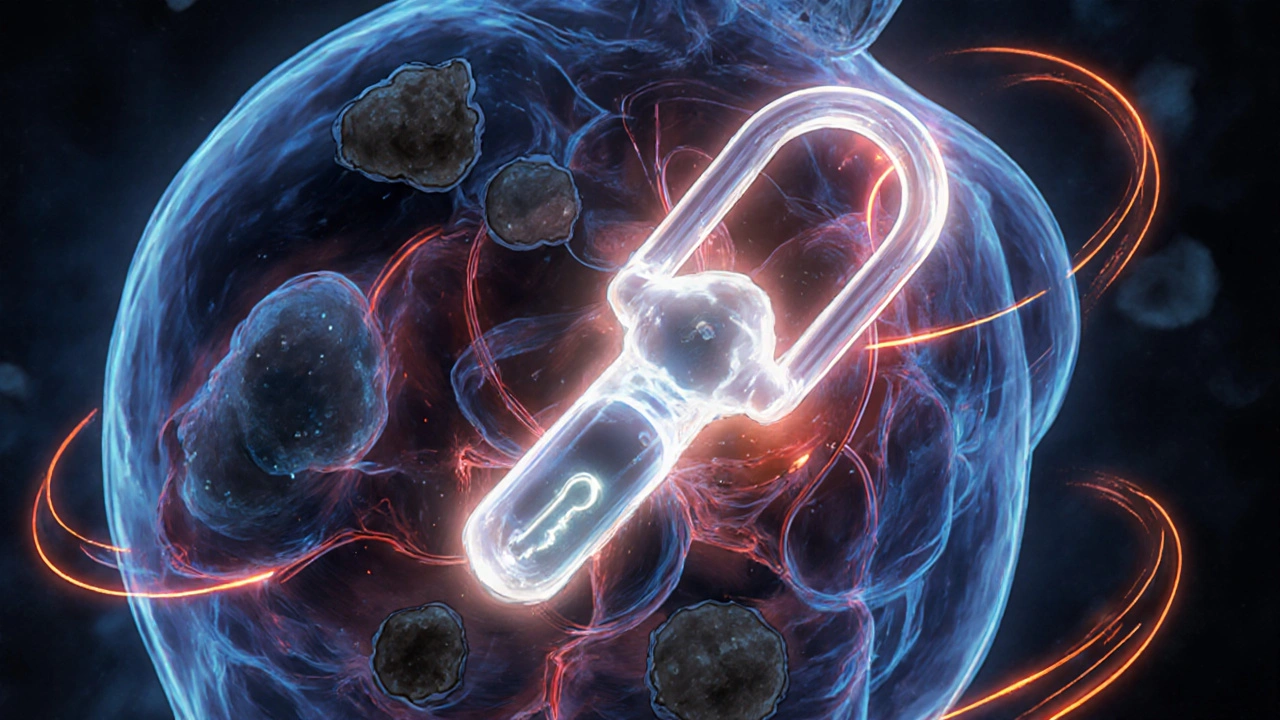By the time most people hear the words type 2 diabetes, the damage has already been building for years. It doesn’t come out of nowhere. It starts quietly-with fatigue, weight that won’t budge, cravings that won’t quit, and a waistline that keeps growing. Behind those symptoms is a silent breakdown: your body’s cells are no longer listening to insulin. That’s insulin resistance. And it’s the engine driving not just diabetes, but a whole cluster of health problems known as metabolic syndrome.
What Exactly Is Insulin Resistance?
Insulin is your body’s key to unlocking cells so glucose-your main source of energy-can get inside. When you eat, your pancreas releases insulin to tell muscle, fat, and liver cells: Take in the sugar. But with insulin resistance, those cells start ignoring the signal. Glucose stays in your blood. Your pancreas responds by pumping out more insulin to compensate. That’s called hyperinsulinemia. This isn’t just a glitch. It’s a full-blown cellular malfunction. High levels of sugar and fat in the blood, especially from constant snacking and processed carbs, overload the insulin signaling pathway. The message gets blocked. Inflammation kicks in. Fat builds up in the liver and muscles. The endoplasmic reticulum, which helps proteins fold properly, gets stressed. Oxidative damage piles up. All of this makes insulin less effective. Here’s the scary part: 80 to 90% of people with type 2 diabetes have insulin resistance before they’re even diagnosed. Dr. Ralph DeFronzo’s research from the University of Texas Health Science Center showed this decades ago-and it still holds true today. Insulin resistance isn’t a side effect of diabetes. It’s the main reason diabetes develops.Metabolic Syndrome: More Than Just a Label
Metabolic syndrome isn’t a disease. It’s a warning sign. It’s when five risk factors show up together: excess belly fat, high triglycerides, low HDL (good) cholesterol, high blood pressure, and elevated fasting blood sugar. You need at least three of these to be diagnosed. The International Diabetes Federation updated the criteria in 2023. For men in Europe, a waist size of 94 cm or more counts. For South Asian, Chinese, or Japanese men, it’s 90 cm. For women, it’s 80 cm across most ethnic groups. These aren’t arbitrary numbers. They reflect where fat is stored-and where it does the most harm. That belly fat? It’s not just cosmetic. Visceral fat around your organs releases inflammatory chemicals and free fatty acids that directly interfere with insulin. That’s why two people can weigh the same, but only one has metabolic syndrome. Genetics, diet, and activity levels determine where fat goes. And where it goes, determines your risk. In 2024, experts started pushing to rename metabolic syndrome to metabolic dysfunction syndrome (MDS). The old name made it sound like a list of symptoms. The new one says: this is broken biology. It’s not just high numbers. It’s your metabolism failing.How Insulin Resistance Turns Into Diabetes
Your pancreas can keep up for a while. It pumps out more insulin to force glucose into stubborn cells. But beta cells aren’t invincible. Over time, they burn out. Dr. Steven Kahn’s research at Joslin Diabetes Center found beta cell function declines about 4 to 5% per year in people heading toward type 2 diabetes. When insulin production drops below what’s needed to control blood sugar, glucose levels rise past the danger line: fasting glucose above 126 mg/dL (7.0 mmol/L) or post-meal glucose over 200 mg/dL (11.1 mmol/L). That’s when you cross from prediabetes into full-blown diabetes. Prediabetes isn’t a diagnosis you can ignore. It’s your last chance to turn things around. The Diabetes Prevention Program showed that people with metabolic syndrome and prediabetes had a 5 to 6 times higher risk of developing type 2 diabetes than those without. But here’s the good news: lifestyle changes cut that risk by 58% over three years.
Why This Matters Beyond Blood Sugar
Metabolic syndrome doesn’t just lead to diabetes. It leads to heart attacks, strokes, and kidney disease. The Mayo Clinic found that having metabolic syndrome increases your risk of heart disease by 200 to 300%. That’s because the same forces-insulin resistance, inflammation, fat buildup, and high blood pressure-damage blood vessels and promote plaque. Nonalcoholic fatty liver disease (NAFLD) is another silent partner. Up to 70% of people with metabolic syndrome have fat in their liver. If it progresses to NASH (inflammation and scarring), your risk of diabetes more than doubles. And it’s not just the liver. Fat builds up in the heart, kidneys, and even the pancreas itself, making the problem worse. Some experts, like Dr. Anna Gloyn from Oxford, argue that in certain groups-especially lean South Asians-beta cell failure might come first. Genetics can make the pancreas more fragile. But even then, insulin resistance still plays a major role. The American Association of Clinical Endocrinologists says insulin resistance is the unifying thread tying together obesity, diabetes, fatty liver, and heart disease.What You Can Actually Do About It
The good news? Insulin resistance is reversible-at least in its early stages. You don’t need magic pills or extreme diets. You need consistent, doable changes.- Weight loss: Losing just 5 to 7% of your body weight improves insulin sensitivity dramatically. For someone weighing 200 pounds, that’s 10 to 14 pounds. The Look AHEAD trial showed that people who lost 10% of their weight in a year had a 51% chance of reversing prediabetes.
- Exercise: Aim for 150 minutes a week of brisk walking, cycling, or swimming. Strength training twice a week helps too-muscle is the body’s biggest glucose sink.
- Diet: Cut back on sugary drinks, white bread, pastries, and processed snacks. Focus on vegetables, lean proteins, whole grains, nuts, and healthy fats. Fiber slows sugar absorption. Protein and fat help you stay full longer.
- Medication: Metformin is the first-line drug for prediabetes with metabolic syndrome. It lowers liver glucose production and improves insulin sensitivity. In the Diabetes Prevention Program, it reduced diabetes risk by 31% over three years.

Monitoring Progress: What to Track
Don’t wait for symptoms to get worse. Track your numbers.- HbA1c: This measures average blood sugar over 3 months. Normal is under 5.7%. Prediabetes is 5.7-6.4%. Diabetes is 6.5% or higher. Aim for under 7% if you have diabetes.
- Waist circumference: Measure at the narrowest point between ribs and hips. Track changes every 3 months.
- Fasting glucose: Check every 6-12 months if you’re prediabetic.
- Triglycerides and HDL: These lipids tell you about fat metabolism. High triglycerides and low HDL are red flags.
What’s Next? Hope on the Horizon
Research is moving fast. The NIH is investing $1.2 billion into beta cell preservation. Vertex Pharmaceuticals’ stem cell therapy, VX-880, helped 71% of patients reach HbA1c under 7% without insulin in Phase 3 trials. That’s not science fiction-it’s happening now. The European Association for the Study of Diabetes plans to update diagnostic criteria for metabolic dysfunction syndrome by late 2025. This isn’t just about labels. It’s about catching the problem earlier, treating it more aggressively, and preventing complications before they start. The World Health Organization warns that without action, diabetes-related deaths could rise 76% by 2045. But the Lancet Commission on Obesity says coordinated efforts-better food policies, access to care, community support-could cut type 2 diabetes incidence by 40 to 60% by 2035.Final Thought: This Is Your Body Asking for Help
Insulin resistance and metabolic syndrome aren’t punishments. They’re signals. Your body is telling you it’s overwhelmed. The good news? You’re not helpless. You’re not doomed. You’re just at a turning point. You don’t need to be perfect. You just need to be consistent. One less sugary drink. One extra walk. One better meal. Over time, those small choices rebuild your metabolism. They restore your body’s ability to respond to insulin. They turn a diagnosis into a second chance. The clock is ticking-but it’s not running out. It’s just counting down to the moment you decide to act.Can you reverse insulin resistance?
Yes, especially in the early stages. Losing 5-7% of body weight, exercising 150 minutes a week, and eating a whole-foods diet can significantly improve insulin sensitivity. Studies like the Diabetes Prevention Program and Look AHEAD show many people reverse prediabetes entirely within a year. Medications like metformin help, but lifestyle changes are the most powerful tool.
Is metabolic syndrome the same as type 2 diabetes?
No. Metabolic syndrome is a cluster of risk factors-like high blood pressure, belly fat, and elevated blood sugar-that increase your chance of developing type 2 diabetes and heart disease. Not everyone with metabolic syndrome has diabetes, but most people with type 2 diabetes have metabolic syndrome. It’s a warning sign, not the final diagnosis.
Why do some thin people get type 2 diabetes?
While obesity is the biggest risk factor, genetics matter. Some people, especially those of South Asian descent, store fat deep inside the abdomen and liver-even if they look lean. This visceral fat causes insulin resistance. Beta cell dysfunction can also play a stronger role in these cases. About 10-15% of people with type 2 diabetes are not overweight.
Do I need medication if I have metabolic syndrome?
Not always. Many people improve with diet, exercise, and weight loss alone. But if your blood sugar is already in the prediabetes range (HbA1c 5.7-6.4%) and you have other risk factors, your doctor may recommend metformin. It’s proven to reduce diabetes risk by 31%. Medication is a tool-not a failure. It gives your body time to heal while you make lifestyle changes.
How long does it take to see improvements in insulin sensitivity?
You can see changes in as little as 2-4 weeks. Blood sugar levels drop after reducing sugar and increasing activity. HbA1c, which reflects 3 months of average levels, takes longer. Most people see noticeable improvement in fasting glucose and triglycerides within 3 months of consistent lifestyle changes. Weight loss and fitness improvements follow over 6-12 months.
Can metabolic syndrome lead to other health problems?
Absolutely. It’s strongly linked to heart disease, stroke, nonalcoholic fatty liver disease (NAFLD), kidney disease, sleep apnea, and even certain cancers. The same inflammation and insulin resistance that drive diabetes also damage blood vessels and organs. Treating metabolic syndrome isn’t just about avoiding diabetes-it’s about protecting your whole body.
Are there any new treatments on the horizon?
Yes. GLP-1 and GIP receptor agonists like semaglutide and tirzepatide are revolutionizing treatment-they help with weight loss, blood sugar control, and heart protection. Stem cell therapies are being tested to replace damaged beta cells. Continuous glucose monitors are becoming more accurate and affordable. Research into gut microbiome and inflammation is also opening new pathways for prevention and reversal.


 Medications
Medications